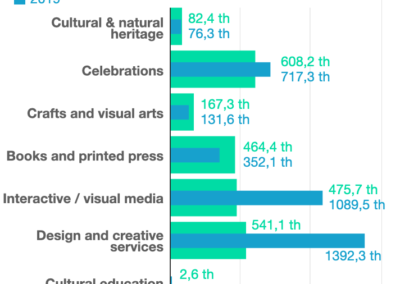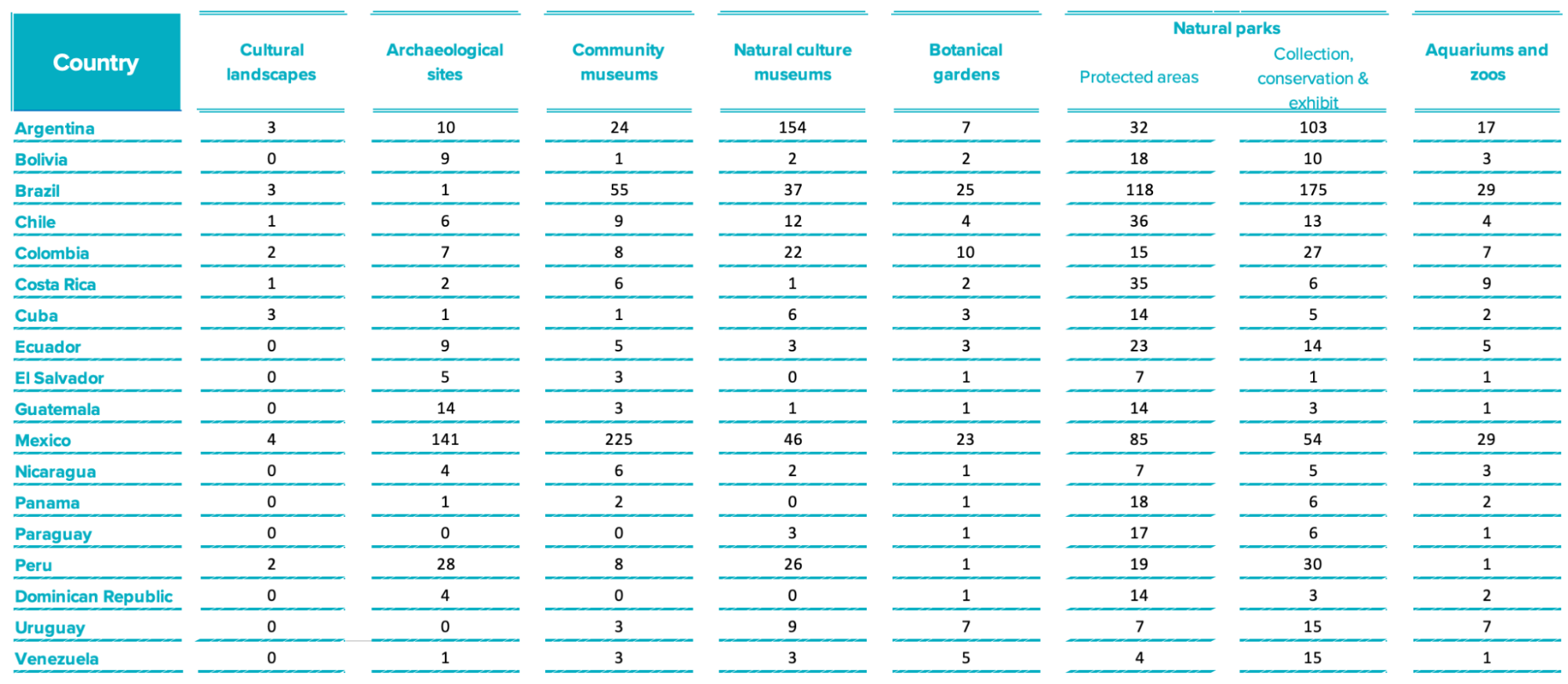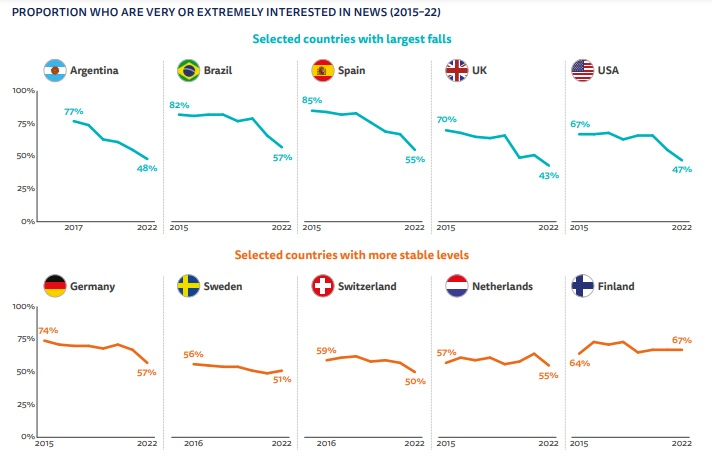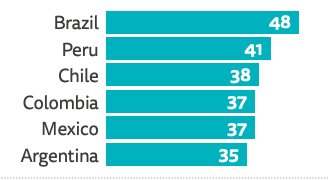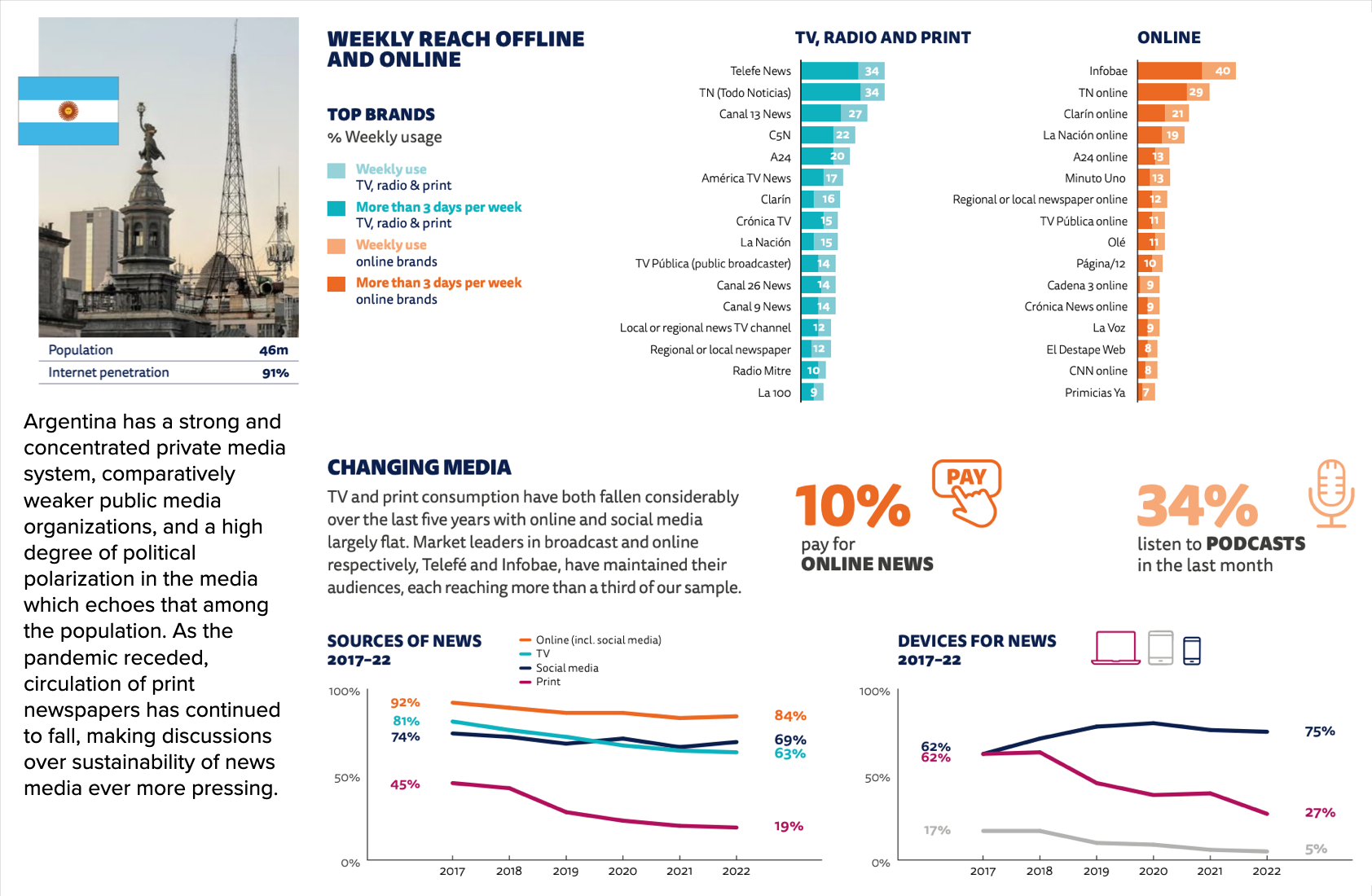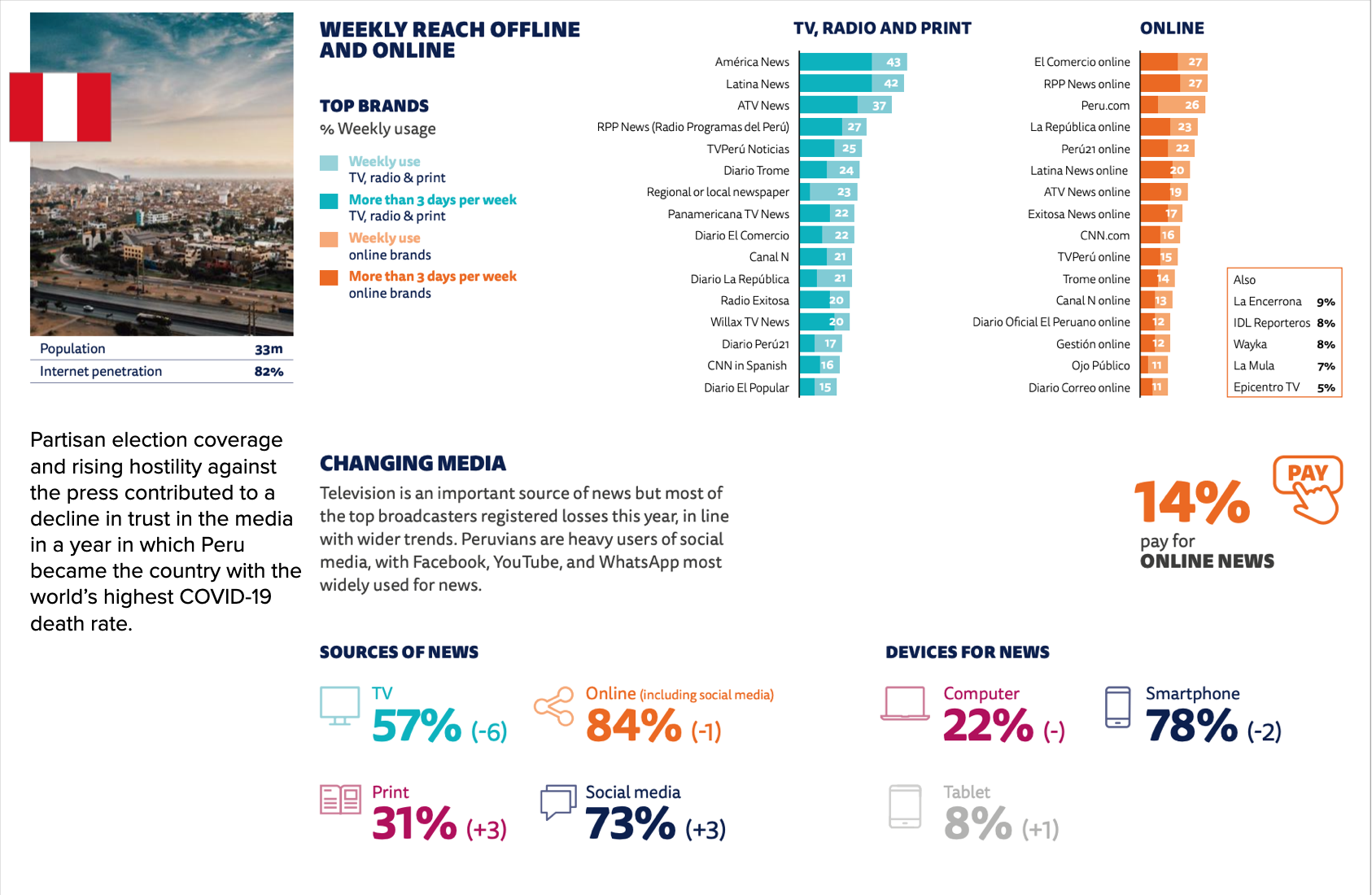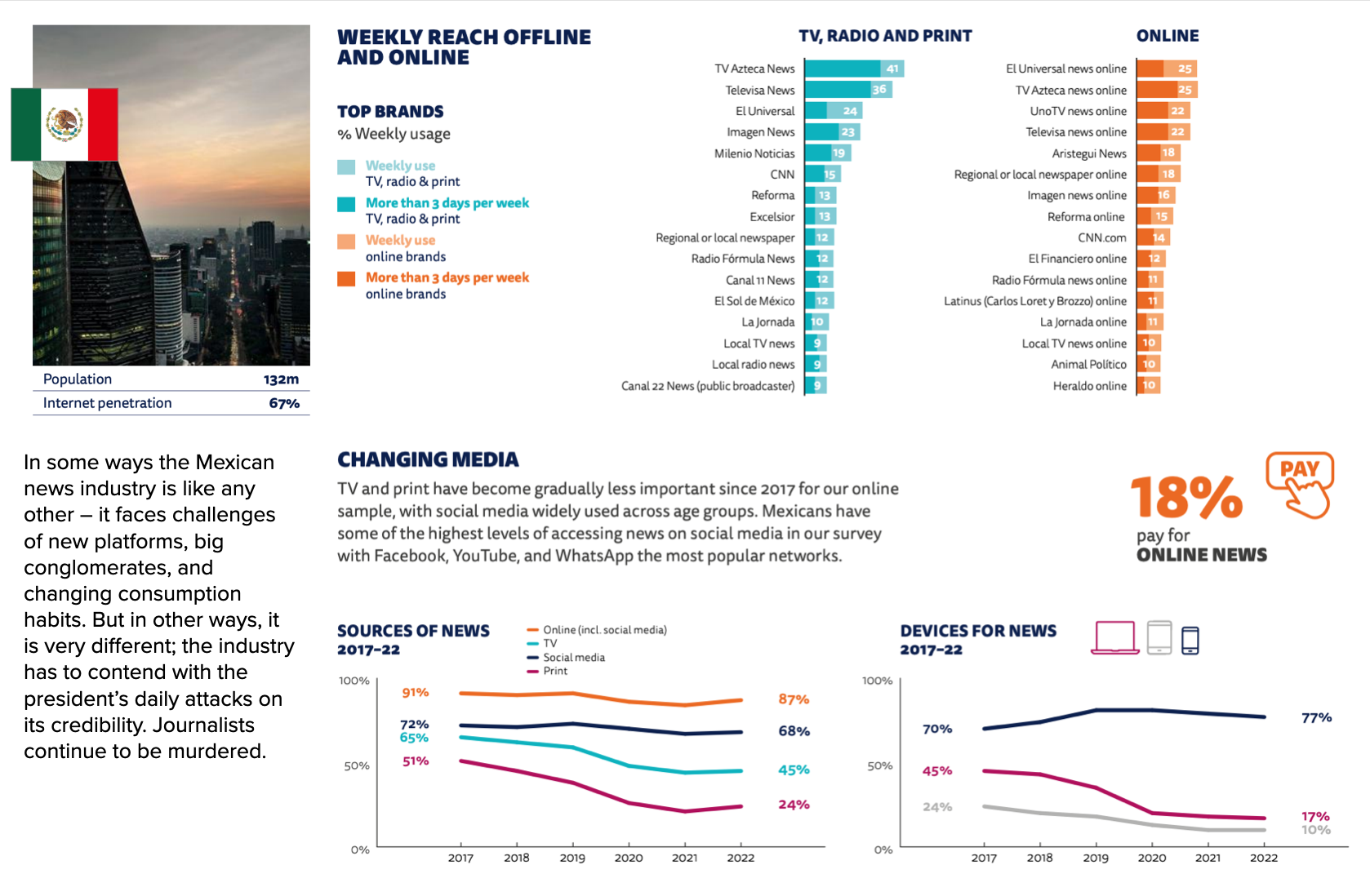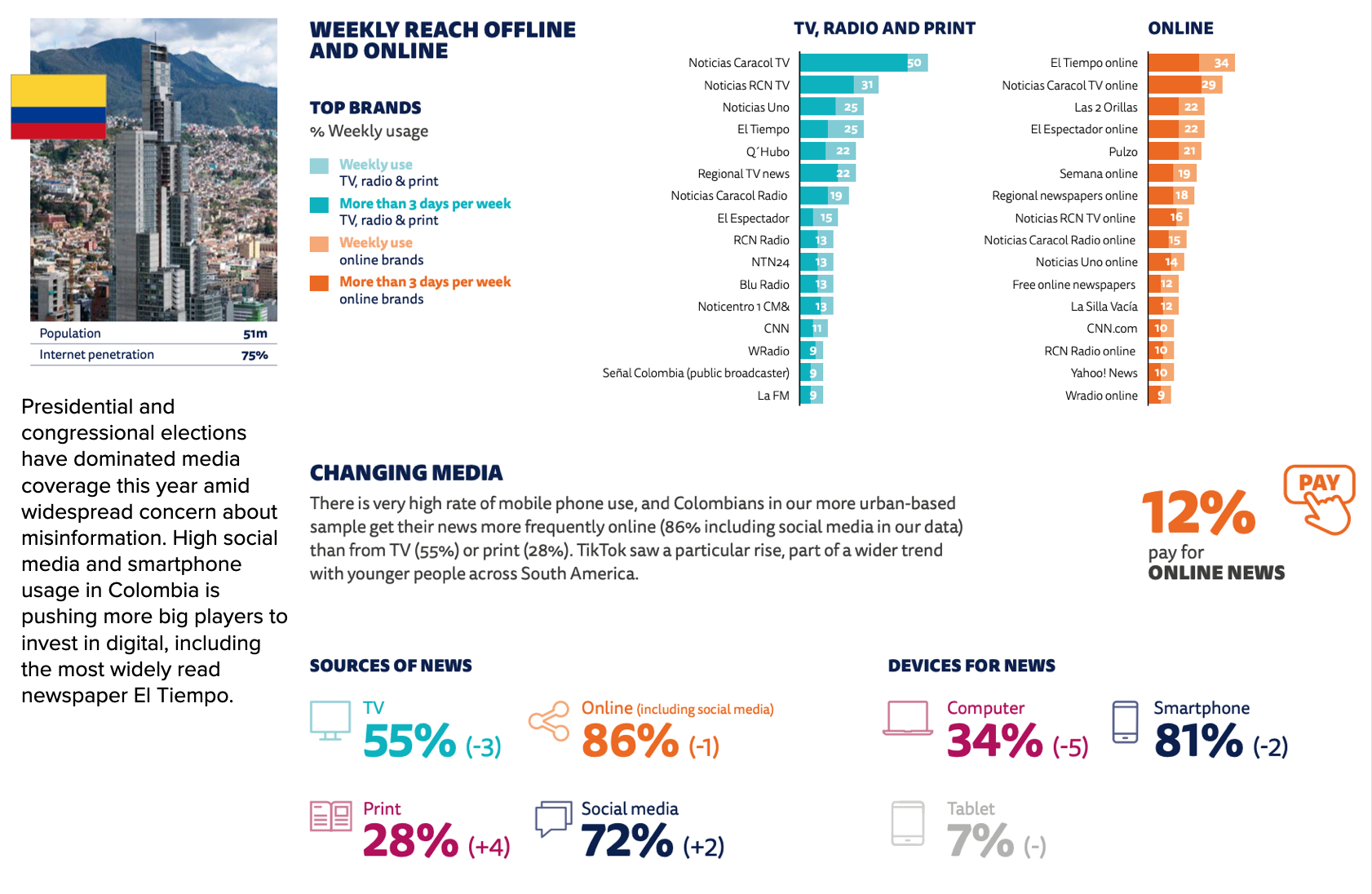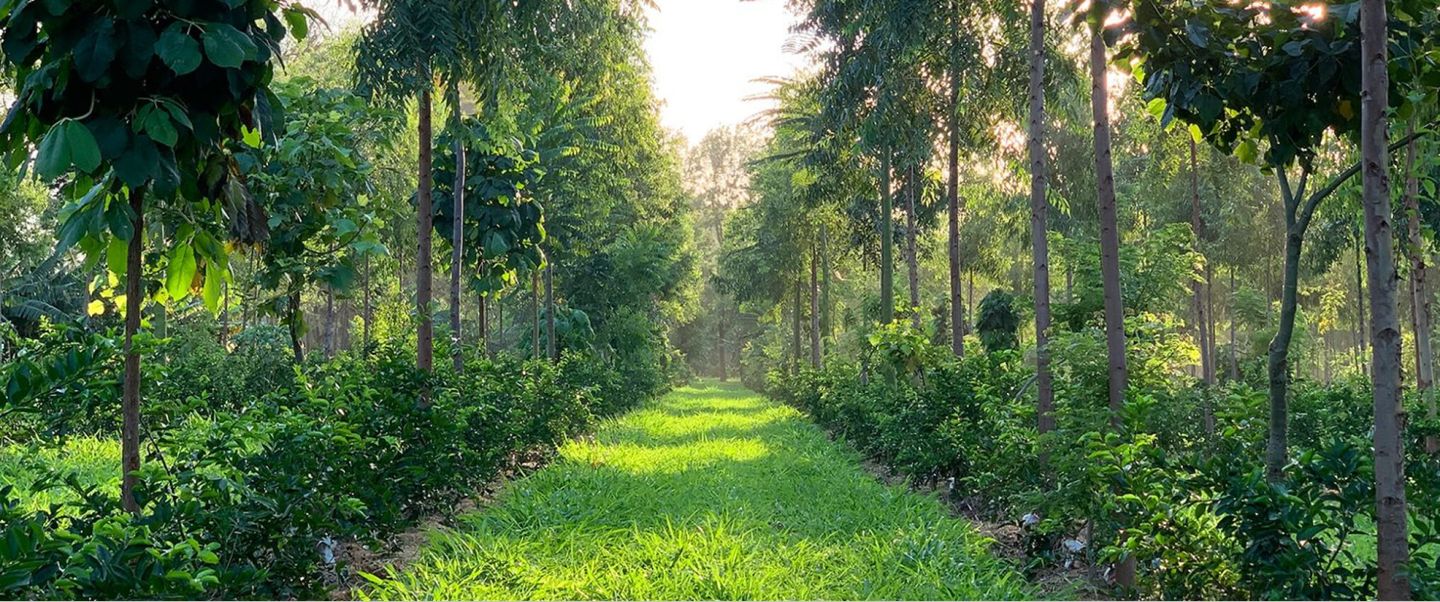2022 report
Change & Emergence
in Latin America
Culture & Media
Current Situation
A snapshot of the cultural and creative sector
Public investment in cultural services. Although Costa Rica, Chile, El Salvador and Uruguay are the countries that invest the most in culture, a decreasing trajectory in central government spending on cultural services is perceived throughout the region, the exception is El Salvador, which increased spending between 2019 and 2020.
Jobs in the cultural and creative sector. It is estimated that in 2019 around 3.7 million of people participated in the cultural sector in Latin America. This corresponds to 1.7% of total employment, an increase of 0.3 % from 2012. Visual and interactive media along with designs and creative services offsetted the decrease in “celebrations” and “books and press”.
Trust in the news has fallen in almost half the countries around the world and consumption of traditional media, such as TV and print, declined further in the last year in almost all regions, with online and social consumption not making up the gap.
Facebook remains the most-used social network for news. While older groups remain loyal to the platform, the youngest generation has switched much of its attention to more visual networks. TikTok has become the fastest growing network.
Sources: 5.1 Taken from the report “Gasto público en cultura en América Latina y la Unión Europea” PDF with data from ECLAD’s Economic Development Division 2021. 5.2 Taken from ECLAD’s report “La contribución de la cultura al desarrollo económico en Iberoamérica”; sample of 14 countries does not include Mexico and Argentina for disaggregation issues. 5.3 Reuters Institute’s Digital News Report 2022. Taken from Insider Intelligence site with data from eMarketer, November 2021.
Current Situation
Selected problems snapshot
Size of the cultural and creative sector
Latin America is a region rich in natural and cultural attributes of great diversity. The region has enormous creative potential, which is reflected in its music, literature, architectural heritage and nature. For this reason, the creative and cultural industries have grown considerably in recent years, also driven by the spread of digital technologies that facilitate the transmission and dissemination of information.
The most dynamic creative industry in the region is television, which generates 42 billion dollars, almost a third of the total generated by the creative sector.
Latin America is also the birthplace of countless renowned and commercially successful writers, including Gabriel García Márquez, Jorge Luis Borges, Mario Vargas Llosa, Isabel Allende, Paulo Coelho and Arturo Pérez-Reverte.
Likewise, festivals are a very important part of community life within the societies of the region, such as the Carnival in Rio de Janeiro, the celebration of the Virgin of Candelaria in Bolivia or the Inti Raymi Festival in Cuzco. Latin America and the Caribbean has 143 places considered World Heritage by UNESCO, of which 70% are cultural sites.
Consumer behavior of cultural and creative industries

Natural heritage sites in the region
- cultural landscape: they are the result of the interaction over time of people and the natural environment, whose expression is a territory perceived and valued for its cultural qualities, product of a process and support of the identity of a community.
- archeological sites: They have archaeological or historical vestiges and are located within a natural area, providing an integrating vision regarding the human-nature relationship. They have Interpretation Centers or small site museums for visitor information.
- Community museums: They seek to present a comprehensive vision of tangible and intangible cultural heritage and its natural environment, from an approach that is generated within the community (eco-museums, community museums, local museums, etc.).
- Natural culture museums: They have mixed collections (natural and cultural heritage) that cannot be identified by a main collection. Generally these are regional and local museums, which include the natural and cultural history of certain territories.
- Botanical gardens: Its specificity is to cultivate and exhibit scientific collections of living, herbaceous and/or arboreal plants, in order to investigate, conserve and disseminate the plant diversity of a region or ecosystem.
- NP protected areas: Protected green areas, strictly delimited, that constitute representative ecosystems of flora, fauna, and singular geological formations that have exceptional value from the point of view of conservation, science, or natural beauty. The public can visit them and develop various recreational, educational or research activities that are environmentally compatible.
- NP collection conservation and exhibit: Dedicated to the collection, conservation and exhibition of topics related to one or several of the following disciplines: biology, botany, geology, zoology, paleontology and ecology, among others.
- Aquariums and zoos: Its specificity is to keep alive, breed and exhibit different species of terrestrial or aquatic animals, traditionally exotic or wild and currently the native fauna of the country or region.
Source: Source: ECLAD’s report “La contribución de la cultura al desarrollo económico en Iberoamérica”, definitions by Instituto Latinoamericano de Museos (2021).
Cultural heritage sites in the region
- Art museums: Dedicated to the exhibition of works of fine arts, graphic, applied and/or decorative arts. This group includes sculpture, painting galleries, photography and film museums, architecture museums, religious art museums, and exhibition galleries that depend on libraries and archives.
- History museums: Dedicated to presenting the historical evolution of a region or country during a determined period or through the centuries. It includes those of collections of historical objects and vestiges, commemorative museums, archive museums, military museums, museums of historical characters or processes, “memory” museums, among others.
- Anthropology museums: Dedicated to the conservation and dissemination of cultural manifestations that bear witness to the existence of past and present societies. They include museums of archeology and those of ethnology and ethnography that exhibit materials on the culture, social structures, beliefs, customs, and arts of indigenous peoples, ethnic groups, and peasants.
- Science museums: Dedicated to conserving and disseminating the historical, scientific and technological heritage of one or several exact sciences, as well as the various production processes of raw materials or by-products.
- Carnivals: Celebrations whose common characteristic is to be a period of permissiveness and a certain lack of control, marking a break in the social order, which takes place immediately before the start of Christian Lent. By extension, some similar festivals are called that at any time of the year.
- Knowledge and ways of doing: They are the set of knowledge, techniques and practices that communities develop in interaction with their natural environment, and are linked to their referent belief systems: gastronomy, traditional medicine, traditional construction techniques and the variety of craft techniques; Above all, they are knowledge and ways of “know-how” that are transmitted from generation to generation.
- Rituals and celebration: These are the cultural practices and manifestations developed in a spatial and temporal context, such as religious celebrations (for example, Holy Week) and rituals associated with the agricultural cycle or the life cycle of groups and individuals.
- Forms of expression: They are the representations of dance, music, theater, games and other expressions linked to ritual or daily spaces; among them stands out the oral tradition of myths, legends, stories, songs, prayers, literary expressions, as well as narratives of local memory.
Source: Source: ECLAD’s report “La contribución de la cultura al desarrollo económico en Iberoamérica”, definitions by Instituto Latinoamericano de Museos (2021).

Deep dive: Trust in the media
Key findings from the Reuters Institute Digital News Report 2022
- Argentina and Brazil are the countries where their citizens avoid the most access to the news.
- Access to news via the smartphone seems to have reached a plateau, however, the cell phone is the primary way of accessing news, before television, radio or print media.
- Facebook continues to be the most used network globally to access news.
- There is a preference for consuming news via text over audiovisual.
A. Proportion who are very or extremely interested in news – 2015 to 2022. Selected countries with the largest falls
Digital News Report 2022. Analysis of five countries in Latin America
Change signals
Curated trends, signals or opportunities
Global corporate trend pushes regional offices to meet net-zero goals
More than one-third (34%) of the world’s largest companies are now committed to Net Zero, by cutting greenhouse gas emissions to as close to zero as possible, with any remaining emissions re-absorbed from the atmosphere, by oceans and forests for instance. Their Latin American regional branches are seeking qualified talent, service providers and alternative solutions to meet their ambitious goals.
Change signals
Initiative spotlight
Rizoma Agro
A regenerative agricultural practice
Rizoma Agro is a Brazilian agroforestry company that focuses on sustainable production of timber, fruits, and other crops. Founded in 2010, Rizoma Agro has become a leading voice in the movement towards sustainable agriculture and forestry practices in Brazil. The company operates in the Brazilian Amazon region and aims to promote reforestation, agroforestry, and the conservation of native forests. Rizoma Agro’s main product is Brazilian teak, a high-value hardwood used in the production of furniture, flooring, and other wood products. However, the company also produces a variety of other crops, including cocoa, açaí, and cupuaçu.
A regenerative agricultural practice
Agroforestry is a land management system that integrates trees with crops and/or livestock, creating a more sustainable and diverse agricultural system. Agroforestry systems can provide a range of environmental and economic benefits, including soil conservation, carbon sequestration, biodiversity conservation, and increased food security. In agroforestry systems, trees and crops are planted together, allowing for complementary interactions between different species. For example, trees can provide shade for crops, protect soil from erosion, and improve soil fertility by fixing nitrogen. In turn, crops can provide additional income streams for farmers and help to maintain the health of the agroforestry system.
Agroforestry is important to address global warming because it can help sequester carbon dioxide from the atmosphere. Trees are a natural carbon sink, meaning they absorb carbon dioxide through photosynthesis and store it in their biomass and in the soil. By combining trees and crops or animals, agroforestry systems can increase carbon sequestration potential while also providing multiple benefits to farmers and the environment. Additionally, agroforestry can reduce the need for synthetic fertilizers and pesticides, which are often energy-intensive and contribute to greenhouse gas emissions.
Scale of agroforestry in Brazil and its challenges
Despite the potential benefits of agroforestry, its scale in Brazil is still relatively small. Compared to the 263 million hectares under farming systems (2020), which represents approximately 30% of the national territory, agroforestry in Brazil covers around 5% of the farmed land, and there is no information if these agroforests follow the conventional model or are oriented by agroecological principles.
Despite the benefits of agroforestry, the expansion of agroforestry systems in Brazil and Latin America faces several challenges. The main barriers to the adoption of agroforestry at scale in Brazil includes the lack of technical assistance, limited access to finance, regulatory barriers, land tenure issues, and limited market access. Many farmers lack the technical knowledge and support needed to establish and maintain agroforestry systems, while financing options for such projects are often limited. The legal framework for agroforestry in Brazil is complex and can be a barrier to adoption, while land tenure issues and limited market access can make it difficult for farmers to invest in agroforestry systems or find buyers for their products. Additionally, the high upfront costs of establishing agroforestry systems can be a barrier for smallholder farmers, who may lack the resources to invest in long-term land management practices.
Sources: World Agroforestry, 2023. How agroforestry can restore degraded lands and provide income in the Amazon, Mongabay 2023. Schuler, H.R.; Alarcon, G.G.; Joner, F.; dos Santos, K.L.; Siminski, A.; Siddique, I. Ecosystem Services from Ecological Agroforestry in Brazil: A Systematic Map of Scientific Evidence. Land 2022, 11, 83. Farming Destroyed Brazil’s Rain Forests. It Could Also Save Them, Time 2023. Fotos: Ellen McArthur Foundation, 2023 and Mongabay 2023.
2022 REPORT


